所在位置:首页 > 贸促动态 > 市长国际企业家顾问会议 > 往届回顾 > 第九届顾问报告 > 正文
THE BEST PRACTICES TO BE SHARED FOR THE ENDEAVORS OF BUILDING BEIJING INTO A WORLD-CLASS CITY
2012年05月23日 来源:中国国际贸易促进委员会北京市分会
Henri Proglio,
Chairman of the Board, Veolia Environment Group
Preface
The growth of large urban areas is a major phenomenon typical of the modern world. Megacities are not any longer centers of certain countries or areas, but become important node points in the global economic system, and turn out to be “world-class cities”.
How will a city be crowned as a world-class city? Based on human’s experience, a world-class city must be the most prosperous and surprising place. But according to our observation, a revolution of megacities’ development model has been changing the image of world-class cities. In the future, a world-class city will also have to a “green giant”, a leader in the exploration of sustainable development.
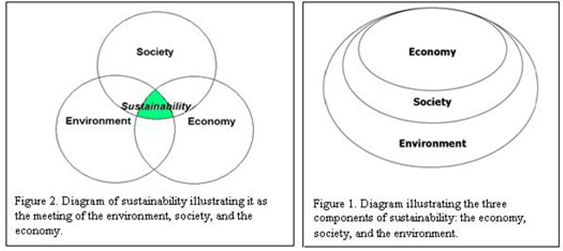
More than half of the world’s population is already living in cities and this trend will continue, but the traditional urban growth is placing increasing pressure on limited natural resources.
Statistics show that 85% of greenhouse gas emissions are generated by urban areas, although cities only occupy 2% of the world's landmass. Such phenomenon makes the response in terms of economic efficiency of the city, social balance, sanitation, environmental challenges and ecological footprint more complex.
City’s future requires a sustainable development strategy – now one of the most robust realities of the actual implementation of sustainable development. It requires a global vision that takes into account the interactions between urban management aspects previously considered as distinct realities.
The increasing awareness of climate change is accelerating this process, because energy needs related to housing, transportation and waste disposal are major causes of the production of greenhouse gases. A significant percentage of these sectors is related to urban planning and management choices.
Over the past twenty years, people keep reconsidering urbanization and the development model of megacities, and some important theories and concepts have been created. “Eco-city” is one of them, and soon wins global wide recognition. Many observers believe “Eco-city” and megacity shall be two sides of one coin.
Eco-City,
Root sustainability into cities
Richard Register first coined the term "eco-city" in his 1987 book, Eco-city Berkeley: building cities for a healthy future.
In its narrowest sense, an Eco-city is a city putting people the core, a city designed with consideration of environmental impact, inhabited by people dedicated to minimization of required inputs of energy, water and food, and waste output of heat, air pollution - CO₂, methane, and water pollution.
An Eco-city can:
– create the smallest possible ecological footprint;
– feed itself with minimal reliance on the surrounding countryside, including efficiently use land;
– use resources better and power itself with renewable sources of energy;
– produce the lowest quantity of pollution possible, composting used materials and recycle it or convert waste-to-energy;
– create attractive town centers with good road and passenger transport access; and
– improve the wellbeing of residents.
Nowadays, Eco-city has gone beyond the boundaries of environment science and business development and trade to include human development, values, and differences in cultures. In fact, many organizations are referring to sustainable human development when talking about Eco-city in order to emphasize issues such as the importance of gender equality, participation in decision-making processes, and access to education and health.
The practices of Eco-city emerged about fifteen years ago, especially in Northern Europe. In recent years, eco-friendly projects are also beginning to emerge in more and more countries. Generally promoted by communities motivated by the protection of the environment and led by aggressive collectivities, the main purpose of these projects is the local implementation of innovative technologies for the preservation of natural resources and the reduction of pollution.
From an energy savings standpoint, it's first the consumption of buildings that is decreasing. Significant progress was made in construction, like resorting to high-performance insulating techniques, improving ventilation in homes, proper orientation of buildings based on the use of the premises and, of course, resorting to renewable energies.
These projects are technological laboratories, but also social laboratories: beyond their environmental "signature", they have a major impact on the quality of life of the inhabitants and the economic attraction of the territory.
Evolution towards Eco-City
Challenge and opportunity for Beijing

After 30-year efforts, Beijing has successfully squeezed into the club of megacities. It catches up and surpasses its predecessors, like New York, Paris, and Tokyo, with surprising speed. Actually, Beijing has surpassed its predecessors in many ways.
In coming decade, Beijing will keep growing at a surprising speed, but it will have to catch up another trend, the megacities’ evolution towards Eco-cities. It a challenge for Beijing, but it is also the city’s opportunity to become a leader among world-class cities.
For any megacity, the right decisions have to be taken and the right policy levers pulled. In addition, new solutions have to be found to respond to the needs of the major cities in emerging and developing nations, where a large part of future urban growth will be concentrated.
Beijing must prove its success in this contest and thus set a new benchmark for urban development in the world.
As an important international partner for Chinese public utilities and environment service industry, Veolia Environment Group are very honored to be invited to provide suggestions and share experience here.
The company was founded in France more than 150 years ago, and operates in 72 countries and on every continent. Through its businesses, Veolia Environment contributes in every country in which it operates to improvements in the quality of urban living, to the invention of sustainable solutions, to the combat against climate
change and to the preservation of ecosystems. The sustainable management of cities—and more generally territories, because it’s sometimes at a regional or provincial level that these issues must be managed—is a major challenge to which we have a lot of experience to contribute.
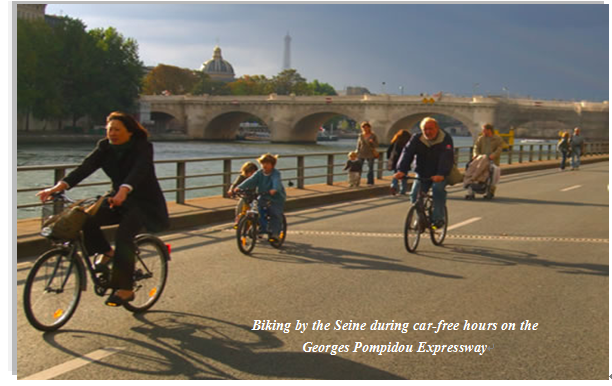
Practices of Eco-City: Give Bus and bicycle priority by restraining car
The Paris Mobility Plan
On April 14, Paris municipal authorities announced that it intended to completely pedestrianize a 1.2 mile stretch of road on the Left 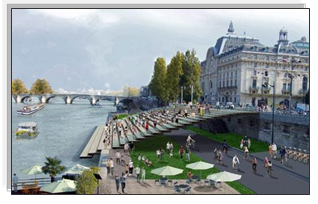 Bank of Seine River. The 40-million euro plan will include huge steps down to the water, as well as gardens, walkways, green "islets" and a barge containing a botanical garden, at aim of “transforming an urban auto route into a living space with areas where there will be no cars”. If it is approved by the town council, express roads along the banks of the Seine built by former French president Georges Pompidou as part of his “great expressway programme” will be closed after 43 years’ serving.
Bank of Seine River. The 40-million euro plan will include huge steps down to the water, as well as gardens, walkways, green "islets" and a barge containing a botanical garden, at aim of “transforming an urban auto route into a living space with areas where there will be no cars”. If it is approved by the town council, express roads along the banks of the Seine built by former French president Georges Pompidou as part of his “great expressway programme” will be closed after 43 years’ serving.
It is the latest action taken by Paris authorities to give priority to bus, bicycle, pedestrian, as well as “beauty and the pleasure of living” by restraining the space of vehicles in the city.
Behind these actions, it is Paris ambitious Mobility Plan, which magically dropped private auto use in Paris by 20 percent in a few short years (2001 to 2006).
Paris authorities understood that new road construction just led to more car trips, further degrading the urban environment. They set out to scale back motorized traffic, focusing instead 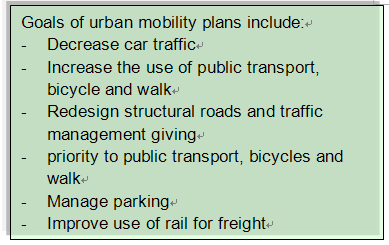 on revitalizing local life and public spaces, by converting acres of roadway and parking spaces into pedestrian space, bike lanes, busways and tramways.
on revitalizing local life and public spaces, by converting acres of roadway and parking spaces into pedestrian space, bike lanes, busways and tramways.
In the summer of 2002, aware of that congestion pricing was completely politically untenable, Paris authorities launched Quartiers Verts ("Green Neighborhoods"). The program was the first initiative to reclaim neighborhood streets for the community. Squares and plazas were renovated, sidewalks widened, and new landscaping and raised crosswalks were added. Measures such as increasing parking rates, reducing the amount of on-street parking, and eliminating free parking areas were adopted altogether. The legal speed limit was lowered to 30 km/h from 50 km/h. A network of pedestrian-priority shared streets was also created, where the legal traffic speed was lowered to 15 km/h. New low-floor microbus circulators were introduced to improve local accessibility and connections to transit stations. 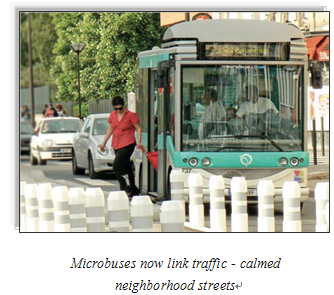
Next major initiative -- Espaces Civilisés ("Civilized Spaces") -- took aim at Paris's most car-friendly boulevards was adopted soon after. After years efforts, Espaces Civilisés yielded its first finished boulevard in 2005, when Boulevard de Magenta was trimmed a six-lane road down to two traffic lanes and two bus lanes, with the remainder going to sidewalks and street trees. So far, about half a dozen such transformations have been completed, with plans for another on the way.
Under the program, 24 million euros were invested (about 260 euros per square meter) into widening sidewalks from 4 to 8 meters, planting trees, and building bikeways. Granite separators were put in to protect a new dedicated bus lane. To accommodate deliveries, 30 minute truck parking spaces were placed on the curb-side of the bus lane. Intersections were made safer with secured crosswalks, widened median refuge islands and extended crossing phases for pedestrians.
 Along with regularly expanding its Metro and tram lines, the Paris administration is also building a light BRT system, the Mobilien. The Mobilien system has dedicated bus corridors, signal priority at intersections, and raised stations for rapid boarding and alighting from any door of the low-floor buses. Fare payment is mostly done by Navigo smart cards and enforced by roaming ticket inspectors. The first three Mobilien lines opened between 2005 and 2006. Though bus ridership was disrupted during construction, by the second half of 2006, ridership on new Mobilien busways increased dramatically.
Along with regularly expanding its Metro and tram lines, the Paris administration is also building a light BRT system, the Mobilien. The Mobilien system has dedicated bus corridors, signal priority at intersections, and raised stations for rapid boarding and alighting from any door of the low-floor buses. Fare payment is mostly done by Navigo smart cards and enforced by roaming ticket inspectors. The first three Mobilien lines opened between 2005 and 2006. Though bus ridership was disrupted during construction, by the second half of 2006, ridership on new Mobilien busways increased dramatically.
These improvements and traffic restraint measures led to a decrease in private vehicle traffic by 20 percent, trucks by 11 percent, and tourist buses by 11 percent between 2001 and 2006. The Metro received the biggest ridership increase, at 12 percent. With the completion of the first Mobilien corridors, bus ridership is also now growing rapidly.
Over the same period, all indicators of air pollution improved regularly, with the exception of summer ozone levels. Six percent of the overall 32 percent reduction in nitrogen oxides (NOx), as well as all 9 percent of the reduction in carbon dioxide (CO₂) emissions, were attributed to the reduced number of cars and trucks in the city. Air quality had strongly improved along the streets and avenues that have been reorganized, with a reduction of 10 micrograms of NOx per cubic meter on many streets. Injuries also decreased by 25 percent between 2001and 2005
The administration has only been charging ahead. In February 2007, it presented a 15-year sustainable Mobility Plan which the Council of Paris approved for public hearings and a final vote in 2008. The 2020 objectives of the plan include:
-reducing traffic by 40 percent;
-reducing greenhouse gas emissions by 60 percent;
-increasing transit capacity by 30 percent;
-and raising non-automobile transportation mode share from 78 percent to 83 percent
The city has become a role model for sustainable transport. Should the next administration receive a renewed mandate to continue these policies, Paris would be able to sustain their revolutionary efforts.
Practices of Eco-City: Recovering more than 50% of the waste
Ludres’ Materials Recovery Facility
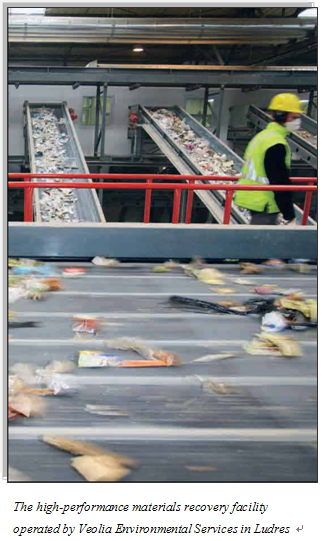
The Ludres high-performance materials recovery facility was officially inaugurated on June 19, 2009 with a nominal annual capacity of 110,000 metric tons.
The sophisticated combination of high-tech machines (optical, aeraulic sorting and ballistic screens), and the production of materials for new processes in recycling and recovery, have positioned the Ludres materials recovery facility at the cutting edge of innovation.
For the first time in France, a new-generation materials recovery facility is recovering over 50% of the incoming waste streams (ferrous and non-ferrous metals, wood, paper, cardboard and plastics). This technology offers many advantages to the level by sorting and recycling remains comparable with means of direct disposal, despite the very low prices of raw materials;
Environmental :
-Less use of fossil fuels, thanks to the production of secondary raw materials and Refuse Derived Fuel (RDF). Some 20% of the incoming waste is converted to high heat value RDF (mixture of plastic, wood and cardboard) ; the RDF can be used, for example, in cement plant and steel mill furnaces, meeting European standards;
-Resource conservation by proposing secondary raw materials produced by recycling (paper and cardboard, wood, ferrous and non-ferrous metals);
-Landfilled tonnage cut by half;
-Materials and energy recovery helps reduce greenhouse gas emissions.
From mixture of non-hazardous industrial waste, it produces secondary raw materials—paper and cardboard, wood, ferrous and non-ferrous metals—and refuse-derived fuel, a first in France. Essentially comprised of non-chlorinated plastics with a high heating value, this refuse-derived fuel, prepared in accordance with European standards, can be used in industrial furnaces and boiler plants for district heating networks, thereby saving fossil fuels.
Another first in France. Laudres MRF’s performance far exceeds the national goal for 2012 set by the Grenelle Environment Forum in France, which stipulates a 15% reduction in the volume of household and non-hazardous industrial waste sent to landfill.
In all, the Ludres MRF recovers more than 50% of the waste collected
Practices of Eco-City: Achieving energy efficiency through retrofitting and biogas
Amsterdam’s ECOSTILER project

ECOSTILER stands for Energy efficient Community Stimulation by use and Integration of Local Energy Resources. It is all about a coordinated approach in achieving energy efficient communities. The common and main element is the use of biogas and district heating systems, successful tools in reduction of primary fuel consumption and CO₂ reduction. The interesting complementarity is the size of the communities, ranging from large to small.
Amsterdam New West is a section of the city of Amsterdam consisting primarily of apartment buildings from the 1950s and 60s. As a part of the ECOSTILER project, more than 300 dwellings are being refurbished with special emphasis on improving energy efficiency, providing inspiration for 50,000 further dwellings that could be renewed in the same way.
Steps being taken include rigorous building shell improvement and insulation, upgrading of heating systems and the domestic hot water supply system, and replacing old windows with high performance new ones. The first completed building, De Leeuw van Vlaanderen, won the 2007 Dutch award for the best renovated building of the year.
Since the building is situated beside a highway, one of the main improvements was a complete change of the internal room arrangements. Previously, the living rooms faced the noisy highway; in the new layout they are facing the quiet street on the other side of the building. The ‘highway’ side has been wrapped in a glass façade as a noise buffer zone.
A second project is Complex 40, consisting of a series of social housing units. Improvements include installation of high efficiency windows with a 30 percent better insulation value than standard double glazed windows, attic and ground floor insulation as well as waste water heat recovery. PV panels have also been installed on the roof.
Meanwhile, the energy supply to the area is benefiting from a new biogas plant, that will convert waste to energy. This will increase the energy conversion efficiency from waste to biogas from 50 to 90 percent, through connection to the district heating system. The plant will also reduce emissions of methane, a polluting greenhouse gas. The buildings renovated by the project will be integrated with the district heating system.
In addition to investments in hardware, Amsterdam organized a stakeholder dialogue on CO₂-saving targets in urban refurbishments. A group of residents, housing associations and city district managers concluded that Amsterdam must strive for a 70 percent CO₂-reduction in each building complex to be renovated. This reduction target is feasible by a combination of heat insulation, connection to heat pumps or district heating and collective purchase of green electricity. Interestingly, this 70 percent target is twice as high as national recommendations for an 'Energy transition in the built environment'. Ecostiler Amsterdam actively promotes these results to Dutch stakeholders.
The plant will also reduce emissions of methane, a polluting greenhouse gas. The buildings renovated by the project will be integrated with the district heating system.
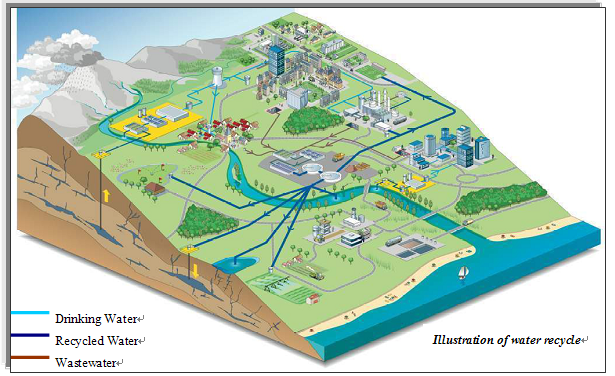
Practices of Eco-City: Making treated wastewater alternative water resource
Berlin’s Integrated Water Cycle Management
Climate change and the economic development (in particular tourism) of some regions may be behind the acute tension over resources (water stress). In these areas, recourse to new sources of water has to be considered in order to safeguard the supply of drinking water, thereby possibly avoiding having to decide between the different ways in which the water could be used (irrigation, industrial activity, tourism).
Recycling wastewater is a possible alternative resource. It comprises recovering the treated wastewater, once it has left the wastewater treatment plant, it undergoing an additional treatment process (which one will depend on what the water will be used for) and to use it for applications which do not necessarily require the use of drinking water.
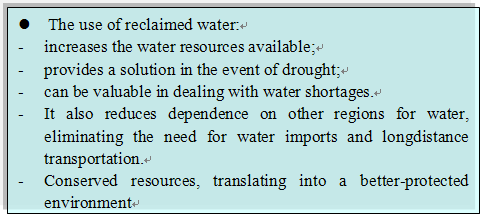 In many parts of the world, recycling water is the solution for increasing water resource availability and reducing environmental pollution. In some arid regions, like Namibia, this resource appears to be the most reliable. More and more governments are adopting an Integrated Water Cycle Management strategy where water recycling is a key part of the water resource management approach
In many parts of the world, recycling water is the solution for increasing water resource availability and reducing environmental pollution. In some arid regions, like Namibia, this resource appears to be the most reliable. More and more governments are adopting an Integrated Water Cycle Management strategy where water recycling is a key part of the water resource management approach
Berlin's State government is one of them. The city seeks to step up its environmental policy and improve the management of groundwater, Berlin's primary resource for meeting the city's domestic and industrial water needs. Integrated Water Cycle Management is a key to sustainable development of the city, and water recycling is a main component. Up to now, 28% of the resource comes from water reuse in Berlin
Berliner Wasserbetriebe, the city’s water and wastewater service provider, developed aquifer recharge facilities in order to meet the strict standards set by the City of Berlin.
The aquifer is recharged both naturally (30%) and artificially (15%) as well as through filtration along lake and river banks (55%). After recycling, wastewater is released into two lakes, where filtration takes place along the banks to recharge the aquifer. In theorty, sometimes, the water can be stored during the wet season and reused later when there is a shortage of water.
Beijing Standard
Build a Key performance Indicator system for urban analysis, impact assessment and energy diagnosis
To systematically evaluate a city’s achievements on sustainable development, and develop a scientific action plan, a system of key performance Indicators is a necessity (KPI).
In recent years, more and more cites have published their own KPI systems. But we have to fact the reality that there won’t be a universal KPI system which matches any city’s situation.
Advisory body under Veolia Environment, the 2EI, has supported supports local authorities of Grenoble to design their urban development programs, while optimizing technical costs.
-Environmental diagnostic audits
-Feasibility studies
-Impact assessments
-Ecological approach to town planning
-Sustainable urban planning
-Pre-bid execution design
KPI system has strategy importance for city’s efforts on sustainable development. Seeking sustainability demands huge investment and input of technology and expertise. KPI can help local authorities set practical goals, both short-term and long-term, for their sustainable development acts, and thus increase cost efficiency.
Beijing, as the capital city of the country of largest population, and an emerging world class city, its experience and practice will provide very significant information for other cities. We hope that Beijing’s KPI system for sustainable development will eventually become a part of the world’s standard.
Sustainability Report
Share Beijing’s experience with the world
Beijing had been misunderstood. Many used to believe there’s no quality air, no quality water, no comfortable and convenient public transportation. But the very successful Olympics changed Beijing’s image. While, Beijing still needs a persistent showcase to display its efforts on sustainable development. Our suggestion is that Beijing shall release its own sustainability report in the name of the municipal people’s government.
We noticed that Beijing had done considerable efforts to promote the city’s sustainability since it was awarded the host of 2008 Olympics. We also noticed with relief that Beijing’s efforts didn’t stop after the Olympics. Actually, the city is even more effortful.
Many actions taken by Beijing, is quite respectable, for example, the driving restriction. We also learned that Beijing is going to restore an important natural watershed in west of the city by investing hundred millions. We believe that all of these efforts will contribute a lot to the city’s sustainability. We also believe that Beijing’s action will gain most valuable experience for many other cities in the world.
We hope Beijing systematically summers its sustainability experience through an annually report.
Conclusion
Beijing still faces many challenges in its way towards sustainability.
Providing everyone with access to basic services and the need to reduce greenhouse gas emissions to slow the pace of climate change require huge environmental investments. The right decisions have to be taken and the right policy levers pulled, to ensure those investments and the related environmental management must be effective and that requires increasing levels of expertise. And there, expertise must go hand in hand with modesty.
Veolia Environment never simply assumes that all we have to do is to import our Western solutions. We must be able to spot good practices that originate in the developing world, and respect social and economic specificities.
主办:中国国际贸易促进委员会北京市分会
建设运维:北京市贸促会信息中心
京ICP证12017809号-3 | 京公网安备100102000689-3号


